Fundamentals of Sound |
|
Fundamentals of Sound |
|
THE EAR AS A TRANSDUCER - Introduction
/ Outer & Middle Ear
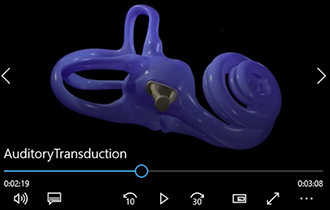 (source) |
Transducers: Devices that convert
|
|
The ear is generally thought of as a sensor (e.g. a microphone) but it actually is
a bidirectional
transducer
|
|
|
TRANSDUCTION PROCESS IN THE OUTER AND MIDDLE EAR |
|
|
OUTER EAR Overall Functions
Main Parts & Functions
|
|
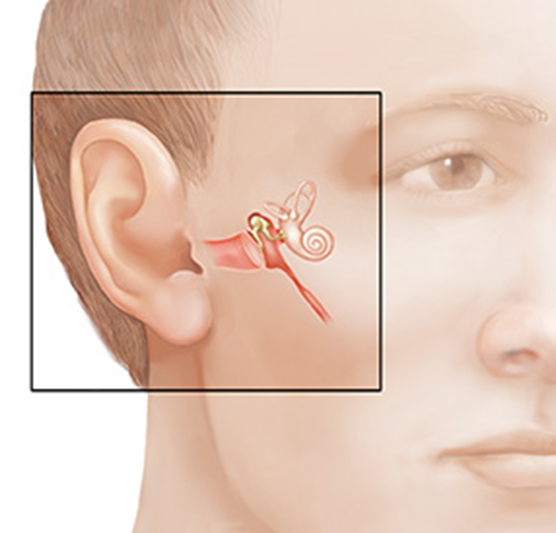
Simplified graph of the ear: in anatomical context (left) and magnified & sectioned (right) |
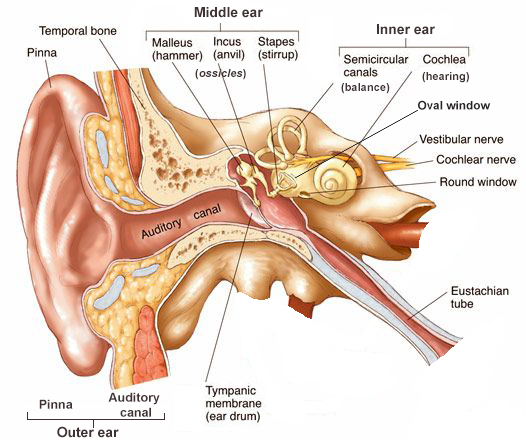 |
|
Schematic:
Longitudinal waves reaching the eardrum
(enlarge - animation) |
|
|
Overall Functions
Main Parts & Functions
The air cavity of the middle ear can connect to the outside via the Eustachian tube, a passage that, when opened (e.g. via yawning or swallowing), functions as an air pressure equalizer between the outer and middle ears (i.e. equalizes the pressure at the two sides of the eardrum). If the air pressure is not equalized, the eardrum's sensitivity drops and its response becomes non-flat (i.e. different sensitivity at different frequencies). |
|
|
(a) (b) (c) (d) (a)
Eardrum motion
& (b)
Ossicle motion animations
|
|
TRANSDUCTION PROCESS IN THE INNER EAR
|
Overall Functions
Main (hearing-related) Parts & Functions The hearing portion of the inner ear consists of the Cochlea, a small, snail-like structure (~9mm in diameter and ~5mm in height) that is split into three liquid-filled compartments (see the pictures, below):
|
|
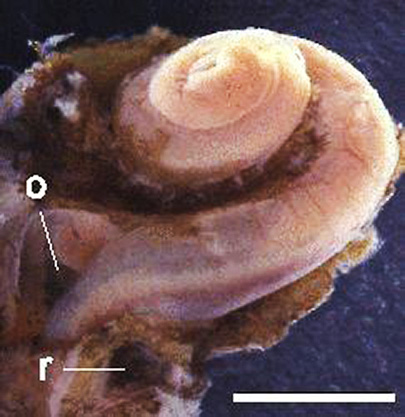 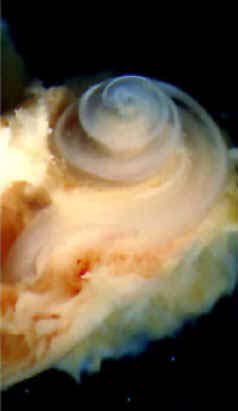 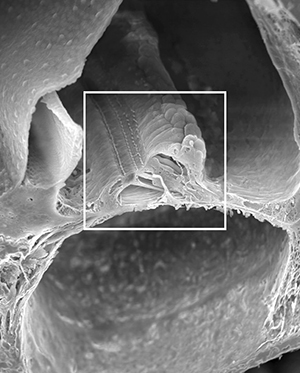
|
←---------------|
Top & Middle: two simplified
schematics of a
stretched-out cochlea; |
|
Above Left: Microphotographs of two intact cochleae
(top and middle)
and of a dissected one (bottom). |
|
|
Schematic cross-sections of the cochleae cochlea Illustrations of the three key compartments or scalas (scala: ladder) and the main transduction element: the Organ of Corti. |
Schematic close-up of the Organ of Corti
The Organ of Corti (OofC) is bounded |
|
Transduction Process in the Organ of Corti - Summary
|
|
Inner-Ear Innervation | |
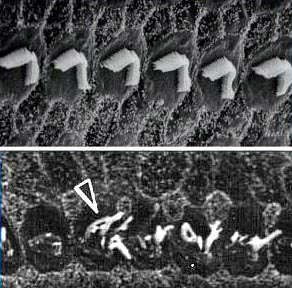
Healthy (top) & damaged (below) hair cells Exposure to high intensity sounds can result in
We will return to Hearing Loss and Conservation during the "Loudness" module. |
• ~30,000 auditory nerve fibers
(neurons) are linked to auditory hair cells
• ~ 5-10% of the nerve fibers are linked to the outer hair cells, whose main function is to compress the level of the incoming signals by increasing response to low level signals and reducing response to high level signals.
• Nerve Fiber's Spontaneous Activity:
Firing activity of a single nerve fiber(neuron) in the absence
of a stimulus.
|
|
Videos outlining the auditory transduction process |
|||
| Additional Videos @ https://www.interactive-biology.com/physiologyvideos/ (videos 036-040) |
|||
|
|||
THE BASILAR MEMBRANE
Auditory Interference - Auditory Masking
Other
Nonlinearities
| Basilar membrane
(BM): A collection of interconnected, weakly-coupled, flexible fibers located
at the basis of the Organ of Corti, in the inner
ear (cochlea). It is a tuned resonator that analyzes complex waves into sinusoidal components.
The resonance range of the human BM and, therefore, the frequency range of hearing (i.e. absolute thresholds for frequency) extends from ~20Hz to ~20.000Hz (20KHz). On average: The structure and function of the basilar membrane was first
hypothesized by Helmholtz and was formalized by Ohm's acoustic law,
theorizing that the inner ear functions as a "mechanical
spectrum analyzer" to break down complex sounds (after 19th
century mathematician and physicist, Georg S. Ohm). |
250Hz:
1kHz:
4kHz: |
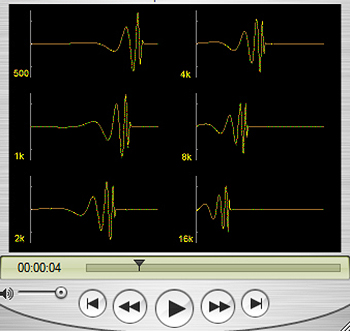
|
|
|
For high frequencies, the basilar membrane vibrates towards the entrance/base of the cochlea, next to the oval window, where the membrane is attached to the bony wall of the cochlea and is thinner, narrower, & tenser/stiffer. For low frequencies, the basilar membrane vibrates towards the apex (top end) of the cochlea, where the membrane is not attached to the bony wall of the cochlea (allowing perilymph to flow between scala vestibuli and scala tympani) and is thicker, wider, & looser.
The tips of tiny hair cells (nerve endings) on the organ of Corti are pushed against the Tectorial Membrane (TM) by the motion of the basilar membrane, translating this motion into electric impulses. |
|
||
|
Critical band: Since von Békésy’s 1930s-1960s studies, the term refers literally to the specific portion of the basilar membrane that goes into vibration in resonance with an incoming sine wave. Its length is determined by the elastic properties of the membrane and, at middle frequencies, has an average value of ~1mm (the term was originally introduced by American physicist, Harvey Fletcher in the 1940s to refer to the frequency bandwidth of the, then loosely defined, auditory filter).
Critical bandwidth: the frequency
difference (~ 1/3 of an octave) corresponding to the
physical length of the critical band .
|
||
|
If the frequency difference between two simultaneous sine waves with comparable levels is within the critical bandwidth, the ear will not be able to resolve the two frequencies and the waves will interact in specific and musically important ways:
|
||
|
Conversely, and as already stated, critical bandwidth can be defined as the minimum frequency separation necessary for two ~equally strong, simultaneous sine waves to sound clearly apart, free from beating and/or roughness. Both, the beating and roughness sensations are perceptual attributes of amplitude fluctuation resulting from sound wave interference (discussed previously). Psycho-physiologically, the beating and roughness sensations are linked to:
[We will return to beating and roughness, when discussing musical timbre, consonance, and dissonance.] |
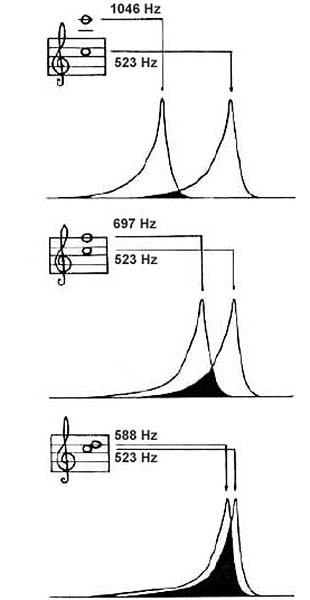 As the interval between two tones
of comparable levels decreases, their respective
disturbances on the basilar membrane (critical bands) increasingly
overlap, resulting in the sensations of roughness and beating |
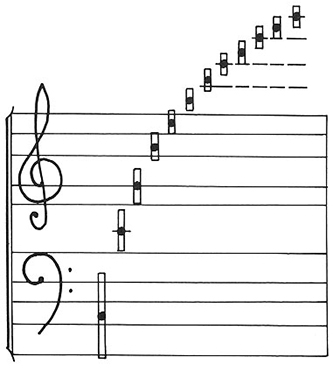
The first 12 components of C3, shown as black circles
on a stretched music-notation 'stave'. |
|
Beating & Roughness Resources
| ||
|
|
|
Simultaneous Masking Term describing the ability of one tone or band of noise (masker) to cover or raise the audibility threshold of a second tone (signal). When two tones (or a band of noise and a tone) close in frequency are
presented simultaneously, one (masker) may mask or “cover” the other
(signal) depending on their level difference: the more intense tone may
mask the less intense tone. The response of the BM around the characteristic (resonant) frequency
is asymmetrical: it is larger above than below characteristic frequency.
Low frequency
tones are more likely to mask (i.e. are more efficient maskers than) high frequency tones. Simultaneous masking may be due to
|
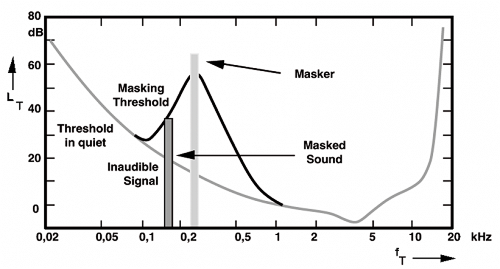 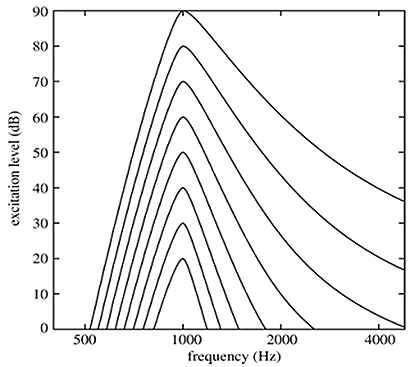
As the level of a signal increases, the BM response
increases in magnitude and width (inverted v-shaped lines,
above). This means that stronger signals are able to cover
increasingly stronger simultaneous signals and increasingly
further removed in frequency. |
|
Temporal Masking During Forward Masking, a signal masks a tone that comes 0-200ms after it. Forward masking does not produce the broad masking effects of simultaneous masking.
During Backward Masking, a signal masks a tone that came
0-50ms before it.
|
|
|
|
|
Distortion
Suppression |
|
|
Otoacoustic emissions The ear acts not only as a microphone, receiving sound, but also as a speaker, emitting a series of tones referred to as otoacoustic emissions (OAEs). OAEs are classified depending on the context of emission (i.e. spontaneous vs. evoked and, if evoked, by what).
Watch this video describing an application of OAEs to hearing assessment and headset tuning. Here is another relevant product. |
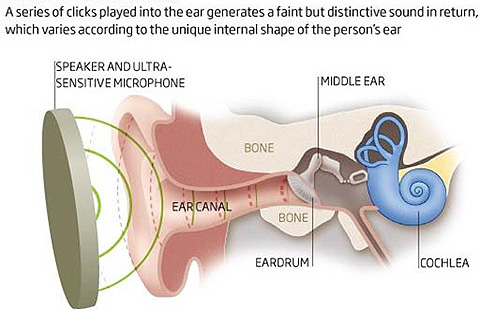 |
|
What Types of Hair Cells and Nerve Fibers Populate the Inner Ear? |
|
Video overview of the hearing transduction path and process (Dr. G. Bhanu Prakash - Animated Medical Videos) | |
|
| |
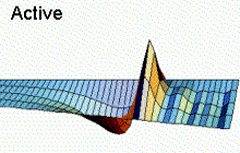
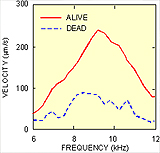
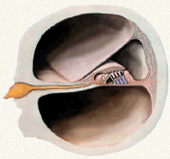
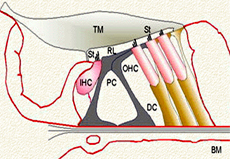 (a) (b) (c) (d) (a)
Basilar membrane vibration animations and (b)
in-vivo (alive) vs. in-vitro (dead) vibration
measurements
|
|
|
(a) (b)
Outer hair-cell
(a)
motility,
and (b)
explanation,
of inner and outer hair-cell function | |
|
Temporal Coding | |
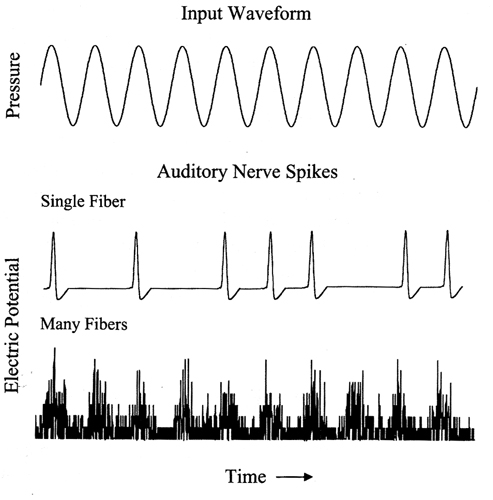 |
Phase Locking and Rectification Neural response (neural firing) follows (or appears to be locked to) the positive peaks in the stimulus, firing only when the stereocilia are sheared in one direction.
This results in the neural signals of sinusoidal inputs
|
|
The process of phase locking is closely related to hearing's "temporal coding theory" of encoding frequency.
| |
|
Place Coding | |
|
| |
|
The above figure illustrates an alternative to the "temporal coding theory" of encoding frequency, referred to as "place coding theory."
As we've discussed, the basilar membrane (BM) responds
at different places for different frequencies, due to
its mass-stiffness gradient. | |
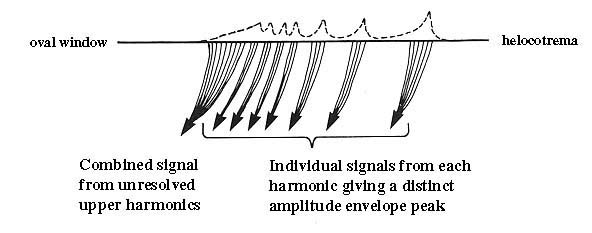 |
The image to the left is a schematic diagram illustrating the signals sent to the brain when the basilar membrane is vibrating in response to a complex wave with many sine components. Each low-frequency component
sends individual signals since, as indicated above, the
frequency separation between the low-frequency components is larger
than the critical bandwidth. |
|
Overview Resources on Ear Anatomy and Function |
|
|
Dangerous Decibels from the
National Institute of Health website. Although the materials are designed for younger audiences (high school students), they present a good basic overview of our topic. |
 |
| Well-designed and concise overview of the anatomy and function of the ear, Part of NeurOreille's Journey Into the World of Hearing. |
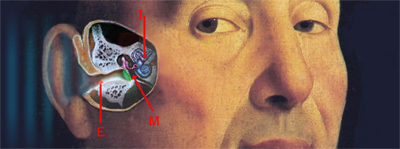 |
|
The Auditory System: Structure and Function, part of
the
Neuroscience e-Textbook site at the Department of Neurobiology
and Anatomy of the McGovern Medical School, University of Texas. This overview goes into more detail, especially in terms of the inner ear. |
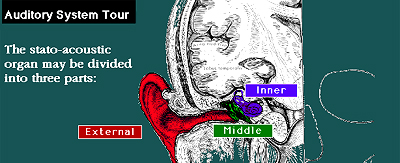 |
|
Acoustics & Auditory Neuroscience Page - City University of Hong Kong (Table of Contents) |
|
|
Interactive Sensation Laboratory Exercises (ISLE) - Hanover College, OH (Chapters 10-13) |
|
|
Details on the nonlinearities of the inner ear - hearing module of a Psychoacoustics course |
|
|
Everything about hearing, including the optional sections, in an 11-minute video! |
|
Loyola Marymount University - School of Film & Television